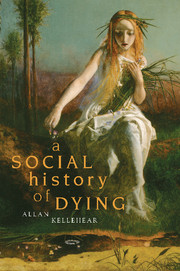Book contents
- Frontmatter
- Contents
- Acknowledgements
- Introduction
- Part I THE STONE AGE
- Part II THE PASTORAL AGE
- Part III THE AGE OF THE CITY
- Chapter Seven The Rise and Spread of Cities
- Chapter Eight The Birth of the Well-Managed Death
- Chapter Nine The Third Challenge: Taming Death
- Part IV THE COSMOPOLITAN AGE
- Conclusion
- Bibliography
- Index
Chapter Eight - The Birth of the Well-Managed Death
Published online by Cambridge University Press: 22 September 2009
- Frontmatter
- Contents
- Acknowledgements
- Introduction
- Part I THE STONE AGE
- Part II THE PASTORAL AGE
- Part III THE AGE OF THE CITY
- Chapter Seven The Rise and Spread of Cities
- Chapter Eight The Birth of the Well-Managed Death
- Chapter Nine The Third Challenge: Taming Death
- Part IV THE COSMOPOLITAN AGE
- Conclusion
- Bibliography
- Index
Summary
How did the advent of cities change the mood and conduct surrounding the good death? The most important cultural observation to make about the rise of the city throughout history is that social relations underwent a structural change. Among peasants and early farmers social relations were close-knit, face to face, small-scale and familiar – meaning quite literally based on kin. Most people in this situation were socially and economically similar – they were farmers or pastoralists. There were a few artisans and Big Men, Chiefs and Shamans who may have performed less or no agricultural work.
In the city, social relations occurred in a context of mass population. Often relationships occurred or were negotiated with ‘strangers’. This feature of urban life, what has sometimes been described as the ‘anonymity’ of city life, is a function of the rapid proliferation of specialised occupational roles. City life was in most respects quite different from rural settlement life: anonymous, large-scale, fragmentary and a place where relationships could be fleeting, instrumentalist, diverse and changing.
At the turn of the 20th century many sociologists observing the major changes and social disruptions wrought by the European Industrial Revolution sought to develop concepts that might act as shorthand descriptions for these changes. Ferdinand Tonnies (1933), for example, wrote about the distinctions between Gemeinschaft (community) and Gesellschaft (association). Tonnies hoped to capture some of the social spirit or culture of relations by emphasising the quality of the relationships inherent in the two types of society.
- Type
- Chapter
- Information
- A Social History of Dying , pp. 147 - 168Publisher: Cambridge University PressPrint publication year: 2007
- 1
- Cited by



